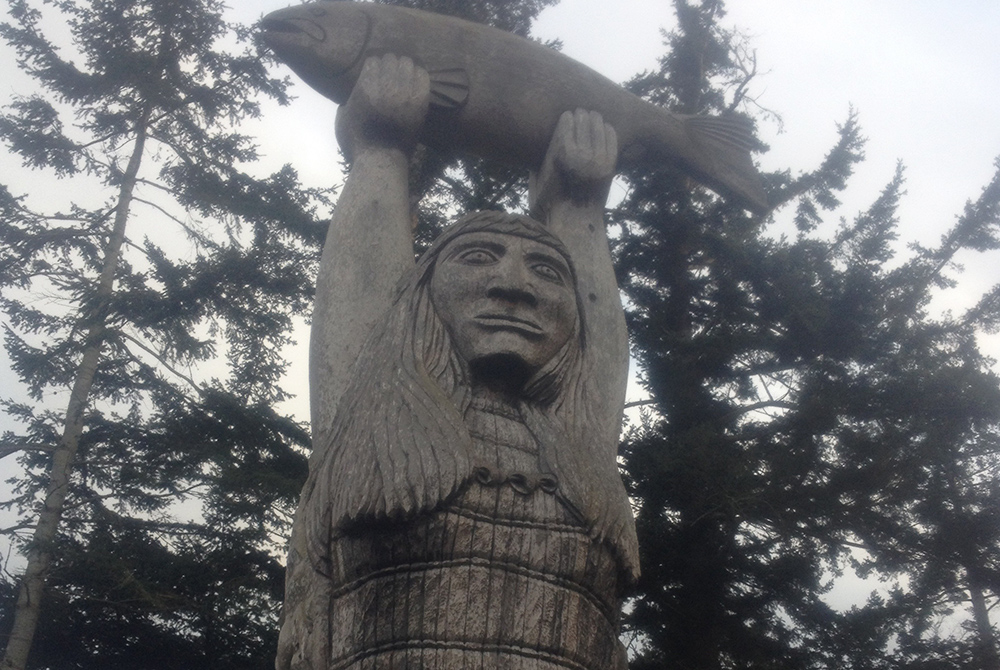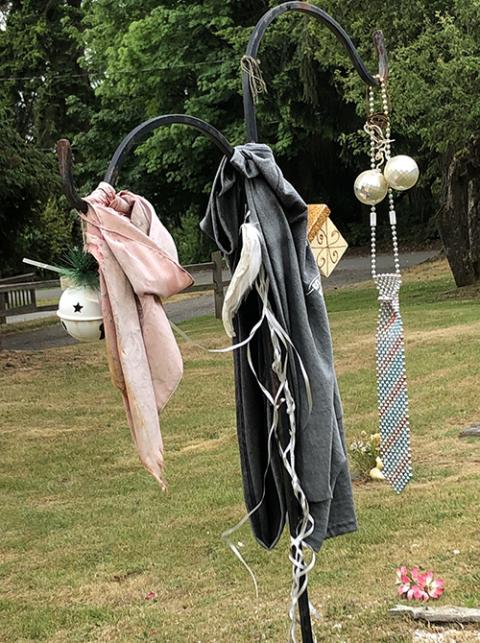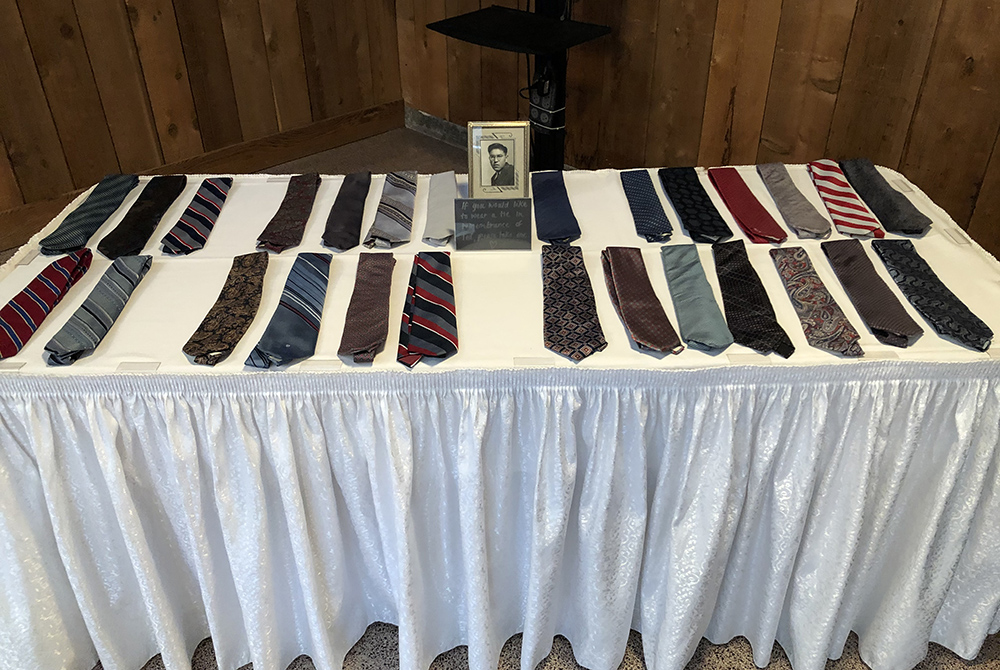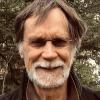
A totem called "Ko-kual-alwoot" ("Maiden of the Sea"), carved by a Swinomish tribal member, stands near Deception Pass at Rosario Beach on the coast of Puget Sound, a few miles from the Suquamish Reservation. Ted George fulfilled the responsibilities of his professional life but remained on his family's reservation lands in Puget Sound. (Courtesy of The Cedar Tree Institute)
Editor's note: There are corners of our world where insights and perspectives of the elderly are, more often than not, received with appreciation and respect. In the values and practices of many Indigenous communities, such traditions still can be found. This commentary, published on the day declared by Pope Francis as World Day for Grandparents and the Elderly, lifts up the power passed down by Ted Doyle George (1928-2021), a S'Klallam tribal elder.
It's Friday morning. Mist hangs on branches of towering red cedars bordering an Indian cemetery on the outskirts of the village of Suquamish, Washington. We're here for the burial of a 92-year-old leader of the Pacific Northwest's Salish Indian community. An Anglican liturgical service will be taking place in a few minutes. This afternoon, a larger celebration is planned at the newly built Suquamish tribal community center a few miles away.
Karlene, Ted George's wife of 48 years, steps out of one of a dozen cars that have arrived. She called a week ago to let me know of Ted's death. She carried no expectation that I would be here today. My close friend Ron Adams, now living in Tacoma, a former Peace Corps volunteer, community organizer, teacher, and one-time colleague of Ted's, is with me. As we approach, Karlene looks up. And covers her eyes with her hands.
I've traveled a thousand miles to kneel before his gravesite this morning. In my pocket is a deerskin bag with a handful of northern white cedar from the shores of Lake Superior. A light rain begins to fall. In a few minutes, at the close of this committal service, as our gathering disperses, this gift from the earth will be laid gently on his gravesite.
Twenty yards away, near the cemetery's tree line, falls a shadow from another grave marker: Chief Sealth, a signatory of the Point Elliott Treaty of 1855, the renowned Suquamish/Duwamish tribal leader after whom, long ago, the city of Seattle was named.

Mementos honor a grave at the Suquamish cemetery, not far from the place where Ted George is buried. (The Cedar Tree Institute)
Bridging Native and non-Native cultures
Most of us who lose parents at young ages are, by psychological necessity, destined to a lifelong search for mentors who will provide support and counsel. Ted George was such a mentor for me. Later that afternoon, as hundreds of tribal members and friends gathered around a festive meal of salmon and clams, we were reminded how he served a similar role for countless children and adults over his long life. Along with eight children, Karlene and Ted were grandparents to 19 grandchildren and 25 great-grandchildren.
By choice, Ted George lived in the border country between Native and non-Native cultures. He danced along on that precarious high wire with integrity, courage and humor. When pushed too hard, he knew how to yield. Strategically, he looked for win-win solutions in heated encounters. In contentious settings, I watched, often with astonishment, how his smile and laughter defused tensions until he pivoted, then adroitly suggested new ways of looking at emotionally driven, complex legal issues.
Over 50 years, he forged a deep sense of spirituality with Karlene. Both resonated with faith-based initiatives and prayerful liturgies that spoke to social issues dealing with race, human rights and economic justice. He was for Karlene a companion and guide into the many paradoxical riddles of contemporary Native American life. She was, for him, a steady presence. A sounding board and "bullshit" detector among the vicissitudes and shifting realities of living on and off tribal reservation lands.
Ted George now joins the ancestors. He leaves behind important lessons about community organizing, resiliency, and the gifts and personal costs that come along with a devotion to cross-cultural justice work.
One evening, he and I were returning from a conference at the University of Washington. I was driving him to the ferry that left Seattle to cross over to his home on the Kitsap Peninsula. Confessing my unease when he introduced me, earlier, during a Tekakwitha Conference (an annual gathering of Indigenous Roman Catholics in North America), I said, "Ted, I'm uncomfortable with the many positive comments you made about me to the workshop participants."
He responded with corrective instruction, as always gently delivered: "Jon, in the old, deep traditions of our people, no one ever lifts oneself up. One is expected to always lift up others. When it's time, you will be lifted up. I know that's not the way most people live. But that's our way."
Advertisement
A deeply spiritual educator
Ted George had a career as an educator. He taught in an elementary school, served as administrator for Indian education in the North Kitsap School District, then helped establish the American Indian Studies Department at the University of Washington. He also played a role in organizing the Small Tribes of Western Washington.
In the 1970s, he was appointed to the National Advisory Council on Indian Education by both Presidents Richard Nixon and Gerald Ford. He later chaired the council, and, as his obituary states, his testimony before the U.S. Senate was instrumental in eliminating Indian boarding schools.
Ted George spent the last, most influential years of his professional life as a western U.S. regional program director for the Administration for Native Americans. He developed strong personal boundaries along the way. When pressured by federal officials to move to Washington, D.C., he negotiated an agreement: He would fulfill his responsibilities but remain on his family's reservation lands in Puget Sound.
In 1987, the interfaith Church Council of Greater Seattle, in response to a challenge by Puget Sound Indigenous leader Jewell Praying Wolf James of the Lummi Nation, issued "The Bishops' Apology," a commitment by 10 major religious leaders to 46 tribes of the Pacific Northwest.
The bishops and denominational executives confessed their faith communities' historical complicity in suppressing American Indian spiritual traditions. They pledged to protect and help recover traditional Indigenous spiritual practices and ceremonies. That commitment involved supporting the Colorado-based Native American Rights Fund in financing legal expenses for litigation on similar issues across North America. The 10 religious leaders also pledged to stand alongside tribes in struggles to restore sacred sites and protect tribal natural resources.
Ted and Karlene George were present on the Thanksgiving morning in Seattle when the apology was presented. The ceremony took place near the site of a forgotten burial ground where Native American remains had been recently unearthed during a construction project.
Over ensuing months, "The Apology" became a heated focus for secular media. The newly forged partnership of local tribes with mainstream church leaders soon resulted in the halting of major commercial developments in the San Juan Islands and, in following years, the return of aboriginal lands and the protection of Snoqualmie Falls.
Everything has a cost. Ted, like many gifted leaders who serve as communicators between cultures, was no exception. He shared with me that earlier in his career, he was driving south on Interstate 5 north of Seattle. Pulling over to the side of the road, he sat there for an hour or more.
"At that moment, at the very peak of my professional career, I had no idea who I was," he said, "No idea where I was. No idea where I was going."
He found his balance, thanks to Karlene and a renewed grounding in his spiritual life. But not before he went through a period of discernment and inner transformation. Ted was not one to "play Indian." He respected and honored tribal traditions, but also felt comfortable and at home in the prayer services of the Episcopal and Anglican Church. He lived in both worlds.
Together, Ted and Karlene lived in a modest home on the Suquamish Reservation, surrounded by cedar trees — one of the few pieces of property still owned by tribal members with a view of the Sound, high on a ridge looking west over a bay.
After I moved with my family to Michigan, I visited as often as I was able, bringing gifts of maple syrup and venison from Michigan. I always was received, like so many others who visited their home, with remarkable hospitality and exquisite welcome. It was as if I was coming home.

Ties that belonged to Ted George are displayed at the funeral gathering. One of the Indigenous leader's sons invited guests to carry home a tie if it "spoke" to them. (Courtesy of The Cedar Tree Institute)
Drums, shared meal and ties
My traveling companion and I join the larger funeral gathering that takes place, later as planned, that afternoon at Kiana Lodge. It's attended by hundreds of tribal members and friends.
The community conference and gathering place is an impressive structure built, in part, with casino revenues. This afternoon's event is framed with the sounds of drums, tables of traditional foods of salmon and clams, and tributes by members of the Suquamish, Lower Elwha and Port Gamble S'Klallam tribes.
A dozen of Ted's ties are displayed on a table along with other mementos, certificates of commendation, photographs and a newspaper clipping from his time serving as a softball coach. Before the closing blessing, one of Ted and Karlene's sons, Matthew, currently working in communications in California, approaches the microphone with a smile, offering an invitation: "Anyone who may feel one of those ties speaking to you, please carry it home."
My friend and I return to our car in the crowded parking lot and begin the hourlong drive back to Tacoma. Weaving through the traffic, we wind our way along the peninsula's waterway. Its sprawling new homes, condominiums and commercial properties define the Kitsap Peninsula in ways that a decade ago were inconceivable. To the east, across the Sound, Seattle, known as the Emerald City, spills over with masses of newly arrived high-tech workers who mingle uneasily along garbage-strewn downtown streets and among increasing homeless populations.
One of the components of justice work, Ted would often say, is the importance of institutional memory. My colleague, the former Peace Corps volunteer who for years worked with the Church Council in partnership with regional tribes, echoes a similar conviction.
He likes to remind non-Natives who work with tribes that American Indian treaty rights are legal agreements built into the fabric of our country's political history. Like all treaties, they are part of our country's institutional memory. They can be abrogated, at any time, if the government chooses to do so.
Supported by vested economic interests, Slade Gorton, a Washington state senator, built an incendiary political platform during the 1980s suggesting just such legislation. That wasn't the first time tribal sovereignty was placed in jeopardy. It won't be the last.
The U.S. federal assimilation policy of the 1950s for Native Americans, and generations of boarding school education that destroyed language and culture, both point to reactive, narrow-minded political forces that could eventually lead to total elimination of Native American treaty rights.
Earlier, at the end of the funeral celebration at the lodge, tribal members of the Sacred Water Canoe Family closed the gathering with a Paddle Song, a song of journey, a metaphor for death. And life.
Our society's current challenge to build deeper ways of living with the Earth has no historical precedent. As a global community we are witnessing climate change, depletion of natural resources and economic disparities that drive us into planetary dystopia. Insights and historical perspectives of our country's 579 American Indian tribes and Alaskan Native groups hold powerful promise to become a central part of a new, more hopeful vision.
Recently, the nonprofit institute with which I'm affiliated in the Great Lakes Basin completed a six-year native plant restoration project with a nearby Anishinaabe community. As our program came to an end, a collaborator, a greenhouse builder from Colorado with plenty of experience working with Indigenous communities across North America, offered this thoughtful lesson.
"For any initiative to be carried forward, there will need to be fire carriers, those individuals who carry a dream within their own community. To know what it takes to make things happen. To help bring peoples and cultures together. They will be leaders, modest but strong, encouraging and visionary. As with any community, they are few. And far between."
Thank you, Ted, for being that gift to us all.
[Jon Magnuson is director of the Cedar Tree Institute, a nonprofit organization that provides services and initiates projects in the areas of mental health, religion and the environment. From 1985-95, he served as co-chair of the Native American Task Force for the Church Council of Greater Seattle. During that time, he was a Lutheran university pastor and a faculty member with the University of Washington's Department of American Indian Studies.]








